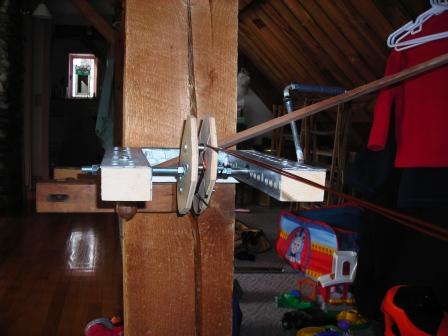Greetings,
Moving s l o w l y, but in the same direction, I wound another test coil. I made some changes to winder. It is a bit heavier and split now so I can remove the coils pretty quickly. The head end can also be rotated if needed to get the strans to lay in tighter. I also built a spool holder/wire tensioner. It seemed to work pretty well, though I continue to find little tricks, as with any new skill-set (practice makes perfect). Attached are some pics. This coil is wound with 2x #14 enameled wire; 53 turns. It is very close to Mitch’s detailed drawings. Here's the run down on our assumptions:
magnet size (inches)-
length: 3.0
width: 1.5
thickness .75
volts: 58.0
#poles: 16
rpm: 95
rps: 1.58
telsa 0.70
#coils / ph: 4
average emf: 4.0
sine wave form factor: 1.1
rms volts / ph: 4.4
Surface Area of Magnets:
l x w = sq in =
3.0 1.5 4.5
x = sq cm =
6.4516 29.03
Total Flux / Pole: telsa x area (sq cm/10) mWb
0.70 2.03
rms volts/ph = DC Volts / 1.73 / 1.4 = RMS Volts / ph
58 1.732050808 1.414213562 23.68
line volts
41.01
Speed is: 95 rpm
1.58 rps
frequency = pn / 2 (where p = #poles, n = rps)
rps x #poles / = freq (Hz)
1.58 16 2 12.67
line Volts / rms/ph / (tot flux / pole / 1,000 / ) freq = #turns/ph
23.68 4.40 2.03 1,000 12.67 209
#turns/ph / coils/ph = turns/coil
209.0 4 52.3
The somewhat higher cut-in voltage is to allow a bit of 'room 'above the normal charging voltage (48V nominal bank) to allow the Classic to work as recommended by halfcrazy.
We're planning to individually vacuum cast the coils - similar to the Bob Shau approach some my remember - all of the connections will be external. Neilho made a the insulator/terminal holder(s). It uses a material called ultem with a brass stud. We have marine grade compreesion ring terminals that will attach the connecting wires and terminal boots that then snap fit over the insulator. Similar to a right-angle spark plug fitting (sorry, i didn't get a picture).






Anyhow, the next step is to suspend the coil between the magnet rotors and spin it up, then make any adjustments needed.
I'd appreciate any input. Specifically, I'm looking for a recommendation on high temp epoxy (~250 deg F, but rough estimate) with the desirable properties (strong, reasonably work/set time, thermally conductive, UV resistant, etc.). I attempted to reach Bob S., but so far haven't heard. I don't know if he still visits the site. Others may have favatorites?
kind regards,
~kitestrings
-edit JW- fixed errors with images (above)